
We’ve already discussed how to protect your beautiful fine art photography from being damaged by acid, sunlight, and UV rays. There are still other dangers we have yet to cover in this series. Another danger which could befall your wall art is that of falling damage. Yep we need to discuss protection from falls. So that’s what we’re talking about today: how to protect your fine art from the damage of falls.
You must consider what will happen to your expensive artwork if it gets dropped accidentally. The broken shards of glass or frame might cut up the paper of your fine art print. You need to take some steps to prevent this from happening. Frames and glass are often cheaper to replace than the artwork itself.

Let’s first consider the danger of the glass in front of the giclée print. Regular glass will often shatter if accidentally dropped. Acrylic will not. This will protect your fine art photo print. Your trade-off is that acrylic is not as scratch-resistant. Since we’re talking about high end wall art, scratching is not nearly the problem that it is for windows or aquariums.
The second consideration is proper hanging so that your art won’t be falling to begin with. You need to make sure that whatever you choose to hang your art on and with, it can support the load on the wall. An alligator hook may work great for smaller pieces of art but it won’t support the weight of a huge and heavy frame with a large picture in it. Neither will a thumbtack nor a tiny nail work for the job either.
If you would like to read up some more on different hanging methods for wall art check out this article here. Be sure to also check out this article on the best kinds of mounts for hanging heavy art on drywall. Please weight the item you wish to hang if you have any doubts or questions.
The final thing to consider is whether or not the wall section you chose will support the load that you wish to display on it. Most drywall will hold up given the proper support of mollies and other factors. This means it won’t often be an issue. However, if you find that you have wood paneling to deal with, you might want to double check what’s behind it before you start drilling holes. Thin wood paneling with no backing might not hold up to the weight of the art you want to display.
Protecting your fine art photography is all about making sure you check a few boxes. Start with housing it in a frame which will stand up to some hits, glass which won’t shatter upon impact, wall mounts which will support the weight of the frame, and a wall sturdy enough to support it all. Taking the time to ensure you protect your fine art will help you in earthquake zones most specifically. However, it will pay off for all of you in the end. Protection from falls is important.
We’re almost done talking about ways to protect your fine art photography. Make sure you tune back in next week when we talk about the final point: protecting your fine art from grime.


Receive monthly updates in your inbox from us.

Join our email-only photo of the week club to get the full stories behind how we captured our favorite fine art landscape photos.
We respect your privacy
No More Results